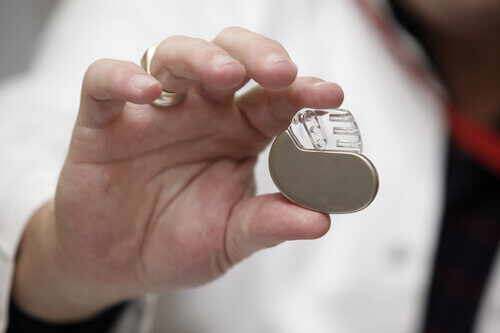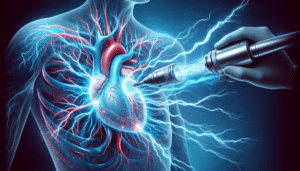Read more about treatment with pacemaker for AFib in this article. Are you or a loved one living with atrial fibrillation (AFib)? If so, you might be wondering, “does a pacemaker help AFib?” While pacemakers have been around for decades, their role in managing AFib is a topic of ongoing discussion among medical professionals. In this blog post, we will delve into the connection between pacemakers and AFib, explore the benefits and risks, and discuss alternative treatment options. By the end, you will have a comprehensive understanding of this complex subject, empowering you to make informed decisions about your healthcare journey.
Key Takeaways
Pacemakers are used to regulate heart rate and reduce the risk of complications in patients with atrial fibrillation, providing symptom relief and improved heart function.
Pacemaker therapy can potentially help address AFib symptoms by providing a more consistent heartbeat, although there are potential risks that must be discussed with a doctor before considering this treatment option.
Alternative therapies for AFib include lifestyle changes, medications, cardioversion and catheter ablation.
Pacemakers and Atrial Fibrillation: The Connection
Atrial fibrillation, a common heart arrhythmia, affects millions of people worldwide. In AFib, the upper chambers of the heart (atria) beat irregularly, increasing the risk of blood clots, stroke, and heart failure. Pacemakers have been used to manage AFib symptoms by regulating heart rate and preventing bradycardia (slow heart rate). Although pacemakers do not cure atrial fibrillation, they significantly contribute to treatment, frequently alongside other therapies.
One of the primary functions of a pacemaker in AFib treatment is to maintain a stable heart rate. This is achieved through electrical impulses delivered by the pacemaker to the heart, resulting in a more consistent heart rhythm. The type of pacemaker used depends on the stage of AFib; dual chamber pacemakers are typically employed in paroxysmal atrial fibrillation, while single chamber pacemakers are used for most patients with persistent or chronic AFib.
Pacemakers can also help to prevent AFib episodes by using rapid atrial pacing therapy, a form of cardiac pacing. This can help address sinus node dysfunction, a common issue in patients with AFib. Nevertheless, pacemakers should not be seen as a sole solution to atrial fibrillation, they are not a cure. Instead, they are often used in conjunction with medications and other therapies to manage AFib symptoms and reduce the risk of complications.
The Role of Pacemakers in AFib Treatment
In AFib treatment, pacemakers are employed to:
Manage symptoms
Regulate medication utilization by controlling heart rate and preventing bradycardia
Maintain a consistent heart rate through electrical impulses, thus relieving patients from some of the most common and debilitating AFib symptoms.
Addressing AFib Symptoms with Pacemaker Therapy
AFib symptoms can significantly impact a patient’s quality of life, causing issues such as fatigue, lightheadedness, and shortness of breath. Pacemaker therapy may help alleviate these symptoms by maintaining a steady heart rate. By providing a more consistent heart rhythm, pacemakers can help patients feel more energized, less dizzy, and better able to breathe, allowing them to better manage their daily activities and overall health.
Keep in mind, pacemaker therapy may not be effective for everyone and potential risks and complications, such as infection, bleeding, and device malfunction, exist. However, for many patients with atrial fibrillation, pacemaker therapy can provide significant symptom relief, allowing them to enjoy a better quality of life.
Your Complete Guide To AFib: The Essential Manual For Every Patient With Atrial Fibrillation
Indications for Pacemaker For AFib treatment
Pacemakers may be indicated for AFib treatment in certain situations, such as when patients have Sick Sinus Syndrome, Tachy/brady syndrome, or require an AV node ablation. In these cases, a pacemaker can help regulate the heart rate and prevent bradycardia, which can be particularly beneficial for patients experiencing symptoms related to their heart rhythm. Understanding these specific indications can help you and your doctor determine whether a pacemaker is the right choice for your AFib treatment.
Although pacemakers can alleviate some AFib symptoms, they should not be regarded as a cure for the condition. Instead, pacemakers should be considered as part of a comprehensive treatment plan that may also include medications, lifestyle changes, and other therapies tailored to your individual needs and circumstances.
Sick Sinus Syndrome
One situation in which a pacemaker can help is when atrial fibrillation goes too slow. There are circumstances where the pulse can go too slow or even pause. The pulse that you check when you’re checking your heart rate comes from the bottom portion of the heart, or the ventricles, and even though you’re in atrial fibrillation, sometimes the bottom portion of your heart, or your pulse can go too slow, or sometimes even pause. In those cases, a pacemaker can help with that intermittent slowness or pauses. The pacemaker will prevent significant slow heart rate episodes and keep the heart rate steady.
Tachy Brady Syndrome
A second circumstance in which a pacemaker can help is what’s called tachy/brady syndrome. What that basically means is that when you are in AFib, your heart rate is going very fast, and you need fairly aggressive medication to help control the speed of the rapid heart rate. However, when AFib stops and you go back into normal rhythm, your natural heartbeat is very slow. It can be very difficult to balance out the two when you have a fast heartbeat in while in AFIb, and a very slow heartbeat when you’re in normal rhythm.
Sometimes when you’re taking medication for rapid atrial fibrillation, your natural heartbeat then becomes very slow when you get out of AFib. People can then feel dizzy or lightheaded, sometimes patients may even pass out. In these situations, a pacemaker can help balance out the heart rate so that your natural heart rate is not so slow, and then when you are in AFiB, you can better tolerate better medications so that your heart rate is not going so fast during AFib episodes. In these types of situations, a pacemaker can help balance things out between medications, as well as balance out the fast heartbeats and the slow heartbeats as well. A pacemaker is a very useful treatment option for many patients, especially if you’re not a good candidate for more aggressive options like a catheter ablation procedure.
AV node ablation
Pacemakers combined with AV node ablation can be utilized to control heart rate in AFib patients, providing symptom relief when medications are ineffective. This combination of therapies can allow patients to experience improved heart function and a better quality of life.
An AV node ablation is when you burn in the middle electrical connection of the heart, where the electrical impulses of the upper and lower chamber of the heart connect, basically just to control the heart rate. The patient is still frequently in AFIB, but the heart rate is no longer capable of going too fast. It actually ends up going very slow after an AV node ablation. Because your heart rate goes very slow with this type of ablation, it’s required to do it with a pacemaker, or with a patient who already has a pacemaker.
Pacemaker Implantation Process
The pacemaker implantation process involves several key steps, including pre-procedure preparation, the implantation procedure itself, and post-procedure care and recovery. Understanding each stage of the process can help you feel more informed and prepared for your pacemaker implantation.
Before the procedure, there are several important steps you may need to follow, such as stopping blood-thinning medications, attending a pre-admission clinic, and fasting for at least six hours prior to the procedure. Your doctor will provide you with specific instructions tailored to your individual needs and circumstances.
During the procedure, the pacemaker is implanted under local anesthesia with sedative medication in a cardiac catheterization laboratory. The pacemaker is typically situated just beneath the collarbone and connected to the heart using special leads. The procedure usually takes around one hour and is followed by a period of recovery and observation in the hospital. These days, many patients can go home the same day as a pacemaker procedure.
Before the Procedure
Before your pacemaker implantation procedure, following your doctor’s instructions carefully is of utmost importance. This may include discontinuing blood-thinning medications to reduce the risk of bleeding during the procedure. You may also need to attend a pre-admission clinic to undergo various tests and assessments to ensure you are in good health for the procedure.
In addition to these steps, you will likely be asked to fast for at least six hours before the procedure to reduce the risk of complications related to anesthesia. Your doctor will provide you with specific fasting instructions based on your individual needs and circumstances.
During the Procedure
The pacemaker implantation procedure itself takes place in a specialized cardiac catheterization laboratory. Here’s what you can usually expect:
You will be given local anesthesia and sedative medication to ensure your comfort during the procedure.
The pacemaker is typically placed just below the collarbone.
Special leads are connected to the pacemaker and carefully positioned in the heart to deliver the electrical impulses necessary to regulate your heart rate.
The procedure usually takes around one hour to complete, and you will be closely monitored by your medical team throughout the process. Once the pacemaker is successfully implanted, you will be moved to a recovery area for observation before being discharged from the hospital.
Recovery and Post-Procedure Care
Recovery from pacemaker implantation is typically short, with most patients able to return home the same day or following an overnight stay in the hospital. It is normal to experience some tenderness, soreness, and bruising in the area of the implantation site, which may last for several weeks. Your doctor will provide guidance on how to care for the area and when to attend follow-up appointments to ensure proper healing and function of the pacemaker.
Full healing of the pacemaker leads may take a few months, during which time you should follow your doctor’s instructions regarding activity restrictions and any necessary adjustments to your medications. By closely adhering to your doctor’s recommendations, you can help ensure a smooth recovery and optimal functioning of your pacemaker.
Pacemaker Limitations and Risks
Despite the significant benefits pacemakers offer in managing AFib, awareness of their limitations and potential risks is key. Some important points to note include:
Pacemakers are not able to completely eliminate atrial fibrillation, and some patients may still experience occasional episodes of the condition.
Pacemakers may not be able to prevent AFib recurrence in all cases.
There is a possibility of complications such as infection, bleeding, and device malfunction.
Despite these limitations, pacemakers play a vital role in AFib treatment by helping to regulate heart rate and prevent bradycardia, which can lead to better symptom management and improved quality of life for many patients. Discussing the potential risks and benefits of pacemaker therapy with your doctor is crucial to determine if this treatment option suits you.
Does a Pacemaker Cure AFib?
Pacemakers can help treat AFib but cannot cure it completely. Some patients may still have occasional episodes of AFib even after pacemaker implantation. However, pacemakers can track the frequency, duration, and progression of AFib episodes, allowing for treatment adjustments to be made as necessary.
By closely monitoring your heart rate and rhythm, your medical team can make informed decisions about your treatment plan, which may include adjustments to your medications or the use of additional therapies such as cardioversion or catheter ablation. Thus, pacemakers can significantly contribute to managing AFib and enhancing patients’ quality of life.
Potential Complications
Potential risks of pacemaker therapy include:
Blood clots
Infection
Air leak
Malfunction
Before undergoing the procedure, discussing these risks with your doctor is vital. While complications are relatively rare, they can have serious consequences and should be addressed promptly if they occur.
Your medical team will closely monitor your pacemaker function and overall health to help minimize the risk of complications and ensure that you receive appropriate care. By following your doctor’s recommendations and maintaining regular follow-up appointments, you can help ensure the best possible outcome from your pacemaker therapy.
Alternatives to Pacemaker Therapy for AFib
If you and your doctor determine that a pacemaker may not be the right treatment option for your AFib, there are several alternative therapies to consider. Lifestyle changes such as reducing stress levels, abstaining from alcohol and caffeine consumption, and engaging in regular physical activity can help manage AFib symptoms. Medications like beta blockers, calcium channel blockers, and anticoagulants can also be used to manage the condition.
For some patients, more serious treatments are required. These measures include cardioversion and catheter ablation. These procedures aim to restore normal heart rhythm by targeting the areas of the heart responsible for AFib. Be sure to discuss all your treatment options with your doctor to determine the best course of action for your individual needs and circumstances.
Read more about cardioversion procedure here.
Read more about catheter ablation for AFib here.
Summary
In conclusion, pacemakers can play a vital role in the treatment of AFib, helping to regulate heart rate and alleviate symptoms for many patients. However, they are not a cure for the condition and may not be able to prevent recurrence in all cases. It is important to be aware of the potential risks and limitations associated with pacemaker therapy and to explore alternative treatment options as needed. By working closely with your doctor, you can develop a comprehensive treatment plan that addresses your unique needs and helps you achieve the best possible quality of life.
Frequently Asked Questions
Can you still have AFib with a pacemaker?
Yes, it is possible to have atrial fibrillation (AFib) with a pacemaker. Pacemakers can help stabilize heart rate and allow patients to take necessary medication but are not a cure for AFib.
Is ablation or pacemaker better for AFib?
In general, the best option for AFIb is customized based on a person’s individual AFib history and additional medical conditions. Most of the time, an ablation has a better success rate for AFib treatment but is a more aggressive procedure when compared to a pacemaker procedure.
What are the risks and complications of pacemaker therapy?
Pacemaker therapy carries risks such as blood clots, infection, air leak and device malfunction. Consequently, it is important to carefully weigh the risks and benefits of this procedure.
The Best Atrial Fibrillation Book
Your Complete Guide To AFib: The Essential Manual For Every Patient With Atrial Fibrillation

Shop AFib Products on Amazon
KardiaMobile 6-Lead Personal EKG Monitor – Six Views of The Heart – Detects AFib and Irregular Arrhythmias – Instant Results in 30 Seconds – Works with Most Smartphones - FSA/HSA Eligible
13% Off
KardiaMobile 1-Lead Personal EKG Monitor – Record EKGs at Home – Detects AFib and Irregular Arrhythmias – Instant Results in 30 Seconds – Easy to Use – Works with Most Smartphones - FSA/HSA Eligible
$79.00 (as of June 16, 2025 15:14 GMT -06:00 - More infoProduct prices and availability are accurate as of the date/time indicated and are subject to change. Any price and availability information displayed on [relevant Amazon Site(s), as applicable] at the time of purchase will apply to the purchase of this product.)
Apple Watch Series 9 [GPS 41mm] Smartwatch with Storm Blue Aluminum Case with Silver Sport Band M/L. Fitness Tracker, Blood Oxygen & ECG Apps, Always-On Retina Display
(as of June 16, 2025 08:46 GMT -06:00 - More infoProduct prices and availability are accurate as of the date/time indicated and are subject to change. Any price and availability information displayed on [relevant Amazon Site(s), as applicable] at the time of purchase will apply to the purchase of this product.)
Fitbit Sense 2 Advanced Health and Fitness Smartwatch with Tools to Manage Stress and Sleep, ECG App, SpO2, 24/7 Heart Rate and GPS, Shadow Grey/Graphite, One Size (S & L Bands Included)
10% Off
OMRON 2-in-1 Upper Arm Blood Pressure Monitor & 1-Lead EKG Monitor - Clinically Validated Blood Pressure Arm Cuff & Machine - Use OMRON Connect App
24% Off
Samsung Galaxy Watch 6 44mm Bluetooth Smartwatch, Fitness Tracker, Personalized HR Zones, Advanced Sleep Coaching, Heart Monitor, BIA Sensor, Health Wellness Insights, Big Screen, US Version, Graphite
$353.21 (as of June 16, 2025 07:34 GMT -06:00 - More infoProduct prices and availability are accurate as of the date/time indicated and are subject to change. Any price and availability information displayed on [relevant Amazon Site(s), as applicable] at the time of purchase will apply to the purchase of this product.)
Natural Rhythm Triple Calm Magnesium 150 mg - 120 Capsules – Magnesium Complex Compound Supplement with Magnesium Glycinate, Malate, and Taurate. Calming Blend for Promoting Rest and Relaxation.
$20.77 ($0.17 / Count) (as of June 16, 2025 07:34 GMT -06:00 - More infoProduct prices and availability are accurate as of the date/time indicated and are subject to change. Any price and availability information displayed on [relevant Amazon Site(s), as applicable] at the time of purchase will apply to the purchase of this product.)
Pure Encapsulations Magnesium (Glycinate) - Supplement to Support Stress Relief, Sleep, Heart Health, Nerves, Muscles, and Metabolism* - with Magnesium Glycinate - 180 Capsules
$44.60 ($0.25 / Count) (as of June 16, 2025 08:46 GMT -06:00 - More infoProduct prices and availability are accurate as of the date/time indicated and are subject to change. Any price and availability information displayed on [relevant Amazon Site(s), as applicable] at the time of purchase will apply to the purchase of this product.)
















![Apple Watch Series 9 [GPS 41mm] Smartwatch with Storm Blue Aluminum Case with Silver Sport Band M/L. Fitness Tracker, Blood Oxygen & ECG Apps, Always-On Retina Display #1](https://m.media-amazon.com/images/I/311xwtp4mFL._SL100_.jpg)
![Apple Watch Series 9 [GPS 41mm] Smartwatch with Storm Blue Aluminum Case with Silver Sport Band M/L. Fitness Tracker, Blood Oxygen & ECG Apps, Always-On Retina Display #2](https://m.media-amazon.com/images/I/41j+8AaUGsL._SL100_.jpg)
![Apple Watch Series 9 [GPS 41mm] Smartwatch with Storm Blue Aluminum Case with Silver Sport Band M/L. Fitness Tracker, Blood Oxygen & ECG Apps, Always-On Retina Display #3](https://m.media-amazon.com/images/I/41jIyxZitnL._SL100_.jpg)
![Apple Watch Series 9 [GPS 41mm] Smartwatch with Storm Blue Aluminum Case with Silver Sport Band M/L. Fitness Tracker, Blood Oxygen & ECG Apps, Always-On Retina Display #4](https://m.media-amazon.com/images/I/41IpNJERjCL._SL100_.jpg)
![Apple Watch Series 9 [GPS 41mm] Smartwatch with Storm Blue Aluminum Case with Silver Sport Band M/L. Fitness Tracker, Blood Oxygen & ECG Apps, Always-On Retina Display #5](https://m.media-amazon.com/images/I/31o17yhfYpL._SL100_.jpg)





































